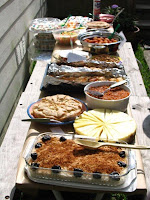They also attract a neighborhood cat who loves to hang out in the back yard. Recently when I went out the patio door, the cat came running up to be petted. Something red was in her mouth. “That’s odd,” I thought. “Why would she eat a firecracker blossom?”
 That’s when she dropped the blossom right at my feet. Well, the bloom turned out to be a ruby-throated hummingbird. Imagine my surprise when I picked it up and it was alive! There was not a single mark on it. I held her in my hand, looking at her while she looked at me, her heart beating so fast I thought it would burst. Her tiny almond-shaped eyes were alert and watchful. The iridescent green feathers were not ruffled. She was so light, like a large moth sitting in my hand.
That’s when she dropped the blossom right at my feet. Well, the bloom turned out to be a ruby-throated hummingbird. Imagine my surprise when I picked it up and it was alive! There was not a single mark on it. I held her in my hand, looking at her while she looked at me, her heart beating so fast I thought it would burst. Her tiny almond-shaped eyes were alert and watchful. The iridescent green feathers were not ruffled. She was so light, like a large moth sitting in my hand. It seemed like an eternity, as she lay still in my palm. My heart beating nearly as rapidly as hers, I held as still as possible, my arm outstretched, offering refuge to this tiny creature that brings such pleasure to me.
After three or four minutes, the hummingbird flew away, back to the feeder. I stood still for awhile, looking at my empty palm and the hummingbird on the wing. What an awesome experience, right there in my own back yard.
Opening up the natural world to your child can be as simple as a walk in the park. Read about the benefits of a life in touch with nature in the book, Last Child in the Woods, by Richard Louv.




